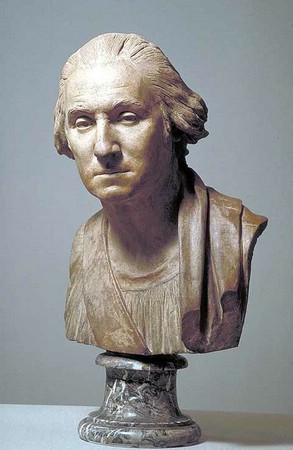Jean-Antoine Houdon (1741-1848) was the greatest of French sculptors — indeed, one of the greatest of all sculptors. His marble portrait busts represent the pinnacle of his art, with their startling realism and feeling of life, deep psychological insight and sublime treatment of the marble itself.
He did famous portraits of most of the leaders of the Enlightenment and standing before these portraits today you feel yourself in the presence of these extraordinary men — closer than even their writings bring you. Voltaire's smile, Benjamin Franklin's genial intellect, Thomas Jefferson's emotional reserve are things you experience directly though Houdon's art. If I recall correctly, the portrait above is of an actress — her dramatic expression is not Houdon's but her own.

Franklin sent Houdon to America in 1785 to make a portrait of George Washington at Mount Vernon, where the hero of the American Revolution sat for a life mask and wet clay models, which became the basis for many subsequent commissions of busts and statues of the great man. In all of them, Washington looks both severe and modest, grand and simple — he could be a teamster or a king, which I guess made him such a perfect candidate for first President of the United States. His mystery, impenetrable even by his contemporaries, remains intact in Houdon's portrait.
My friend Coralie sent me the picture of the bust at the head of this report, which I think she took in the Louvre, from her iPhone just as her plane was about to take off from Paris for her return to Geneva. She said she wanted to share it in case the plane crashed. This makes perfect sense to me. With all of Houdon's portraits, you get a feeling they might change their expression, might leave the room, at any moment. Houdon's work doesn't seem to have been made for the ages, but in the now for the now, whenever that now might be. They have the immediacy of ancient Greek sculpture, of real life coursing through stone — pure miracle.
